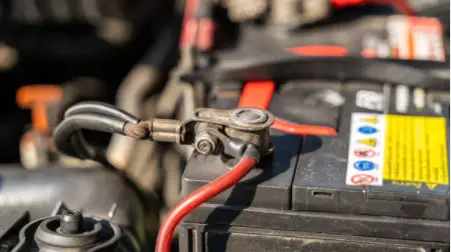Why Disconnect Negative Battery Terminal When Working On Car
When you’re driving your car, you might need to disconnect the battery terminals. There could be a variety of causes for this, ranging from fault diagnosis to battery terminal replacement to complete vehicle maintenance. Though it may appear harsh and demanding, the process is simple and can be completed in minutes.
To avoid terminal damage, use caution when detaching the battery connections. Batteries contain caustic and explosive chemicals in addition to electrical charges. Disconnecting may necessitate the use of a socket wrench and other equipment. As a result, follow the instructions below to disconnect your vehicle’s battery securely.
How to Disconnect the Car Battery Safely
Lead battery terminals corrode if they are not correctly connected or unplugged. Consider battery polarities as well because you can’t just disconnect any terminal. The steps outlined here will show you how to disconnect an automobile battery.
Turn off the engine and follow the safety measures
Turn off the ignition key and recover the vital before disconnecting the battery from the engine. Keep the door open; depending on the model of the car, it may lock when the battery terminal is replaced. Make sure your automobile is in park mode. Put it in the first gear selection if you’re using an automatic transmission or the first gear selector using a manual transmission.
Because the car battery carries electric charges, you must follow specific safety rules when detaching battery terminals. In addition, the automotive battery can release flammable gases. As a result, it is strongly recommended that you keep a fire extinguisher nearby and safety gloves and eye protection.
Locate the battery under the hood
After you’ve turned off the ignition, you’ll need to open the hood and pull the hood lever or press a button usually found below or beside the steering wheel. If you can’t find your car’s hood level, you’ll need to consult its owner’s manual for help.
Some car manufacturers install their batteries in the trunk, hidden from view. As a result, if the battery isn’t in the hood, it’ll be in the trunk of your automobile. After you’ve found the battery, move on to the following step.
To loosen the terminal nut — Check what size wrench you’ll need
Examine your vehicle’s battery and terminals using a flashlight. Determine the wrench size you’ll need to unbolt the nuts visually. Depending on the space available to maneuver the wrench, you will need a couple of twists to complete the operation.
If the terminal employs a single bolt, a single wrench will suffice; however, two twists will be required if the airport uses a bolt and nut. Because most battery cable clamps have 10mm bolts, disconnecting the terminals requires a 10mm flat wrench. A set of socket wrenches with the same size socket will also suffice.
Disconnect the negative cable from the battery
First, disconnect your negative battery terminal to reduce the risk of sparks harming your car’s electronics and causing a battery explosion. Use the wrench to loosen the nut that tightens the negative terminal once you’ve found it. Oppositely turn the twist.
If you know how to detach automobile batteries without tools, carefully wriggling off the cables, you can proceed with your hands once it is free. Remove the nut, but don’t forget to put on your gloves. If your car has a dual battery, follow the steps above, but detach the jumper cable after disconnecting the negative terminal.
In any event, whether you’re working on your car’s electrical system, you must disconnect the negative terminal of the car battery. It’s not necessary to unplug both cords.
Disconnect the positive battery cable
The next step is to detach the positive cable after successfully disconnecting the negative cable. Use the correct wrench from your mechanic toolbox to loosen the nuts and crank it counterclockwise. Bridging the positive and negative terminals of the battery is not a good idea since it can damage the battery or trigger an explosion.
Ensure the positive terminal does not make touch with the automobile chassis; otherwise, the car electrical circuit may be disrupted due to residual charges. It’s also possible that it’ll cause electronic damage.
Please remove the battery strap and pull it out
Most automotive batteries are held in place by a bracket or strap that attaches the battery to the seat. Before you can remove the battery, you must first unscrew the strap.
A large wrench, maybe with a larger diameter, will be required to unscrew the battery. Make a counterclockwise spin with the spanner on the nut. To avoid an electric spark, carefully pull the battery so that both terminals do not touch the metal body simultaneously.
Battery terminals should be cleaned
Moisture can degrade some disconnected battery terminals over time. As a result, verify your automobile battery terminal once you’ve detached it. If you try to start the automobile after reconnecting the battery with a corroded terminal, the engine may not start due to low conductivity. As a result, before reconnecting the battery, make sure the airports are free of corrosion.
To eliminate corrosion
- Scrub the terminals with a wire brush or sandpaper until no debris or dust is evident.
- After removing the decay, spray water on the cables and wipe it away with a clean towel or rag.
- Apply a tiny amount of grease to the terminals once clean and dry to provide lubrication and prevent future corrosion.
Why is it necessary to detach which battery terminal first?
It’s not difficult to disconnect the automobile battery from the engine; you need to know which cable to detach first. If you read this article carefully, you will discover how to separate car batteries for storage if you plan on parking your automobile for an extended period.
When removing the battery, make sure the negative cable is detached first. This is because the battery’s negative connection is attached directly to the car chassis. As a result, if there is a contract between the positive cable and the car body, you can short-circuit the battery.
Why Disconnect Negative Battery Terminal When Working On Car
When you’re driving your car, you might need to disconnect the battery terminals. There could be a variety of causes for this, ranging from fault diagnosis to battery terminal replacement to complete vehicle maintenance. Though it may appear harsh and demanding, the process is simple and can be completed in minutes.
To avoid terminal damage, use caution when detaching the battery connections. Batteries contain caustic and explosive chemicals in addition to electrical charges. Disconnecting may necessitate the use of a socket wrench and other equipment. As a result, follow the instructions below to disconnect your vehicle’s battery securely.
How to Disconnect the Car Battery Safely
Lead battery terminals corrode if they are not correctly connected or unplugged. Consider battery polarities as well because you can’t just disconnect any terminal. The steps outlined here will show you how to disconnect an automobile battery.
Turn off the engine and follow the safety measures
Turn off the ignition key and recover the vital before disconnecting the battery from the engine. Keep the door open; depending on the model of the car, it may lock when the battery terminal is replaced. Make sure your automobile is in park mode. Put it in the first gear selection if you’re using an automatic transmission or the first gear selector using a manual transmission.
Because the car battery carries electric charges, you must follow specific safety rules when detaching battery terminals. In addition, the automotive battery can release flammable gases. As a result, it is strongly recommended that you keep a fire extinguisher nearby and safety gloves and eye protection.
Locate the battery under the hood
After you’ve turned off the ignition, you’ll need to open the hood and pull the hood lever or press a button usually found below or beside the steering wheel. If you can’t find your car’s hood level, you’ll need to consult its owner’s manual for help.
Some car manufacturers install their batteries in the trunk, hidden from view. As a result, if the battery isn’t in the hood, it’ll be in the trunk of your automobile. After you’ve found the battery, move on to the following step.
To loosen the terminal nut — Check what size wrench you’ll need
Examine your vehicle’s battery and terminals using a flashlight. Determine the wrench size you’ll need to unbolt the nuts visually. Depending on the space available to maneuver the wrench, you will need a couple of twists to complete the operation.
If the terminal employs a single bolt, a single wrench will suffice; however, two twists will be required if the airport uses a bolt and nut. Because most battery cable clamps have 10mm bolts, disconnecting the terminals requires a 10mm flat wrench. A set of socket wrenches with the same size socket will also suffice.
Disconnect the negative cable from the battery
First, disconnect your negative battery terminal to reduce the risk of sparks harming your car’s electronics and causing a battery explosion. Use the wrench to loosen the nut that tightens the negative terminal once you’ve found it. Oppositely turn the twist.
If you know how to detach automobile batteries without tools, carefully wriggling off the cables, you can proceed with your hands once it is free. Remove the nut, but don’t forget to put on your gloves. If your car has a dual battery, follow the steps above, but detach the jumper cable after disconnecting the negative terminal.
In any event, whether you’re working on your car’s electrical system, you must disconnect the negative terminal of the car battery. It’s not necessary to unplug both cords.
Disconnect the positive battery cable
The next step is to detach the positive cable after successfully disconnecting the negative cable. Use the correct wrench from your mechanic toolbox to loosen the nuts and crank it counterclockwise. Bridging the positive and negative terminals of the battery is not a good idea since it can damage the battery or trigger an explosion.
Ensure the positive terminal does not make touch with the automobile chassis; otherwise, the car electrical circuit may be disrupted due to residual charges. It’s also possible that it’ll cause electronic damage.
Please remove the battery strap and pull it out
Most automotive batteries are held in place by a bracket or strap that attaches the battery to the seat. Before you can remove the battery, you must first unscrew the strap.
A large wrench, maybe with a larger diameter, will be required to unscrew the battery. Make a counterclockwise spin with the spanner on the nut. To avoid an electric spark, carefully pull the battery so that both terminals do not touch the metal body simultaneously.
Battery terminals should be cleaned
Moisture can degrade some disconnected battery terminals over time. As a result, verify your automobile battery terminal once you’ve detached it. If you try to start the automobile after reconnecting the battery with a corroded terminal, the engine may not start due to low conductivity. As a result, before reconnecting the battery, make sure the airports are free of corrosion.
To eliminate corrosion
- Scrub the terminals with a wire brush or sandpaper until no debris or dust is evident.
- After removing the decay, spray water on the cables and wipe it away with a clean towel or rag.
- Apply a tiny amount of grease to the terminals once clean and dry to provide lubrication and prevent future corrosion.
Why is it necessary to detach which battery terminal first?
It’s not difficult to disconnect the automobile battery from the engine; you need to know which cable to detach first. If you read this article carefully, you will discover how to separate car batteries for storage if you plan on parking your automobile for an extended period.
When removing the battery, make sure the negative cable is detached first. This is because the battery’s negative connection is attached directly to the car chassis. As a result, if there is a contract between the positive cable and the car body, you can short-circuit the battery.


















